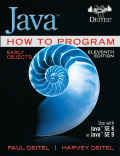
Concept explainers
(Printing the Decimal Equivalent of a Binary Number) Write an application that inputs an integer containing only 0s and 1s (i.e., a binary integer) and prints its decimal equivalent. [Hint: Use the remainder and division operators to pick off the binary number’s digits one at a time, from right to left. In the decimal number system, the rightmost digit has a positional value of 1 and the next digit to the left a positional value of 10, then 100, then 1000, and so on. The decimal number 234 can be interpreted as 4*1 + 3* 10 + 2* 100. In the binary number system, the rightmost digit has a positional value of 1, the next digit to the left a positional value of 2, then 4, then 8, and so on. The decimal equivalent of binary 1101 is 1*1 + 0*2 + l*4 + 1*8, or 1 + 0 + 4 + 8 or, 13.]
Want to see the full answer?
Check out a sample textbook solution
Chapter 4 Solutions
EBK JAVA HOW TO PROGRAM, EARLY OBJECTS
 C++ Programming: From Problem Analysis to Program...Computer ScienceISBN:9781337102087Author:D. S. MalikPublisher:Cengage Learning
C++ Programming: From Problem Analysis to Program...Computer ScienceISBN:9781337102087Author:D. S. MalikPublisher:Cengage Learning C++ for Engineers and ScientistsComputer ScienceISBN:9781133187844Author:Bronson, Gary J.Publisher:Course Technology Ptr
C++ for Engineers and ScientistsComputer ScienceISBN:9781133187844Author:Bronson, Gary J.Publisher:Course Technology Ptr Microsoft Visual C#Computer ScienceISBN:9781337102100Author:Joyce, Farrell.Publisher:Cengage Learning,
Microsoft Visual C#Computer ScienceISBN:9781337102100Author:Joyce, Farrell.Publisher:Cengage Learning, Programming with Microsoft Visual Basic 2017Computer ScienceISBN:9781337102124Author:Diane ZakPublisher:Cengage LearningProgramming Logic & Design ComprehensiveComputer ScienceISBN:9781337669405Author:FARRELLPublisher:Cengage
Programming with Microsoft Visual Basic 2017Computer ScienceISBN:9781337102124Author:Diane ZakPublisher:Cengage LearningProgramming Logic & Design ComprehensiveComputer ScienceISBN:9781337669405Author:FARRELLPublisher:Cengage EBK JAVA PROGRAMMINGComputer ScienceISBN:9781337671385Author:FARRELLPublisher:CENGAGE LEARNING - CONSIGNMENT
EBK JAVA PROGRAMMINGComputer ScienceISBN:9781337671385Author:FARRELLPublisher:CENGAGE LEARNING - CONSIGNMENT





